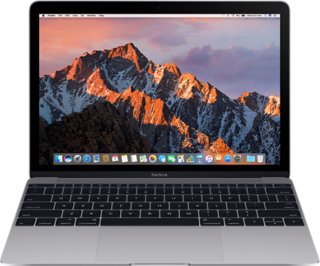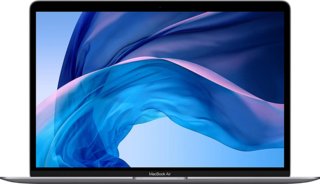Apple MacBook (2016) vs Apple MacBook Air (2020) 13.3" Intel Core i3
Welcome to our detailed comparison of the MacBook (2016) and the MacBook Air (2020). Apple presents two top-tier laptops, each combining style, performance, and portability. Which one suits your needs better? We'll explore their features thoroughly, from processing capabilities to design durability. Sporting a 13.3" display and an Intel Core i3 1.1GHz processor, the MacBook Air stands as a strong competitor. Can it surpass the enduring charm of the MacBook? Stay with us as we analyze these devices comprehensively, providing you with a thorough understanding of their strengths and quirks to assist you in making an informed decision. Let's get started!
System and application performance
Performance in popular 3D games
Viewing angle, color accuracy...
Ports, webcam and other interfaces
Potential battery life
Materials, durability and portability
Design Comparison
Size Comparison
Comparing the design elements of the Apple MacBook (2016) and the Apple MacBook Air (2020) 13.3" allows us to explore how they improve user experience beyond technical details.
Design Elements for Enhanced User Experience:
Weight and Portability:
- The MacBook (2016) is lightweight at 2.03 pounds, making it convenient for portability.
- The MacBook Air (2020) weighs 2.8 pounds, making it slightly heavier than other models but still very portable.
- Both laptops cater well to students or professionals who need mobility, making them ideal for on-the-go use.
Ergonomics and Build Quality:
- The MacBook (2016) has a fanless design that minimizes noise and heat, improving user comfort for extended periods of use.
- Both laptops feature backlit keyboards for comfortable use in low-light settings.
- The MacBook Air (2020) features a fingerprint scanner to enhance security and user convenience during device unlock.
Materials and Aesthetics:
- Both laptops feature Apple's sleek aluminum design, guaranteeing durability and a premium appearance.
- The MacBook Air (2020) features cleaner lines and refined edges that lend it a more contemporary look when compared to the slightly older design of the MacBook (2016).
Connectivity Features:
- The MacBook Air (2020) goes beyond standard USB Type-C ports by incorporating Thunderbolt ports, enhancing data transfer speeds.
- Thunderbolt 3 ports on the MacBook Air improve connectivity for professionals using high-bandwidth peripherals.
Audiovisual Features:
- Both laptops feature stereo speakers for optimal audio quality when enjoying multimedia content.
- An additional microphone in the MacBook Air (2020) improves voice clarity for video calls and recordings.
User-Centric Considerations:
Students: If you value portability alongside performance, consider the MacBook (2016) for its lightweight design.
- Professionals: Professionals looking for improved connectivity options and enhanced performance may prefer the MacBook Air (2020) for its Thunderbolt ports and updated Wi-Fi standard.
Conclusion:
In summary, both laptops showcase distinct design features tailored to various user preferences. The choice between them hinges on individual needs and priorities. The MacBook (2016) prioritizes portability and quiet functionality, ideal for students or casual users. In contrast, the MacBook Air (2020) stands out with connectivity options and contemporary aesthetics, catering more to professionals or users needing enhanced performance.
Screen Comparison
| Apple MacBook (2016) | Apple MacBook Air (2020) 13.3" Intel Core i3 | |
|---|---|---|
| Resolution | Full HD | QHD |
| Screen Size | 12" | 13.3" |
Comparing the screens of the Apple MacBook (2016) and the Apple MacBook Air (2020) 13.3" reveals essential factors that can greatly affect user experience, especially for activities such as gaming or professional graphic design.
Screen Size:
The Apple MacBook (2016) boasts a 12-inch screen, whereas the MacBook Air (2020) sports a slightly larger 13.3-inch display. The larger screen on the MacBook Air can provide a more immersive viewing experience, particularly for tasks like detailed graphic design work or gaming that benefits from a wider field of view.
Resolution:
The screen's resolution identifies its detail display level. The 2016 Apple MacBook offers a resolution of 2304 x 1080 pixels, while the 2020 MacBook Air displays a superior resolution of 2560 x 1440 pixels. For tasks needing exact detail like photo editing or graphic design - where each pixel is critical - a higher resolution screen, like the one on the MacBook Air, provides a significant advantage.
Pixel Density:
Both laptops boast high pixel densities, with the MacBook (2016) at 226 pixels per inch (ppi) and the MacBook Air (2020) at 227 ppi. Increased pixel density leads to sharper images and text, improving the visual quality of games, videos, and detailed design tasks.
Display Technology:
- The laptops feature IPS LCD LED-backlit displays that provide vivid colors and broad viewing angles, ideal for tasks such as graphic design due to their ability to maintain color accuracy and consistency from various perspectives.
Brightness and Contrast Ratio:
- The Apple MacBook (2016) has a brightness level of 387 nits and a contrast ratio of 823.1: 1, while the MacBook Air (2020) maintains similar brightness levels but may offer better contrast ratios due to advancements in display technology over time. A higher contrast ratio can result in deeper blacks and brighter whites, improving image quality for both gaming visuals and graphic design projects.
Hardware Comparison
| Apple MacBook (2016) | Apple MacBook Air (2020) 13.3" Intel Core i3 | |
|---|---|---|
| RAM | 8GB | 8GB |
| Storage Size | 512GB | 256GB |
Comparing the hardware features of the Apple MacBook (2016) and the Apple MacBook Air (2020) 13.3" Intel Core i3 1.1GHz / 8GB RAM / 256 GB SSD involves evaluating critical elements like CPU, GPU, and RAM to gauge their influence on real-world tasks such as multimedia activities or running resource-intensive software.
Apple MacBook (2016)
- CPU: The Apple MacBook (2016) features a CPU speed of 2 GHz with 4 threads.
- GPU: While specific GPU details are not provided, its performance is generally integrated into the CPU.
- RAM: It features 8GB of RAM running at a speed of 1866 MHz.
- Storage: Provides ample 512GB internal storage using flash storage technology.
Performance Impact:
- The Intel Core i3 processor may struggle with demanding tasks compared to newer models.
- The lower RAM speed might result in slightly slower multitasking performance. The expanded internal storage capacity allows for storing a greater number of files without the need to heavily depend on external drives.
Apple MacBook Air (2020) with a 13.3-inch screen, Intel Core i3 processor running at 1.1GHz, 8GB RAM, and 256GB SSD.
- CPU: Running on an Intel Core i3 processor clocked at 1.1 GHz.
- GPU: Integrated graphics within the CPU handle graphical tasks adequately for most everyday use cases.
- RAM: Features 8GB of RAM operating at a faster speed of 3733 MHz.
- Storage: Offers a smaller but faster NVMe SSD with a capacity of 256GB.
Performance Impact:
- The newer generation CPU may provide improved power efficiency and better performance in light to moderate tasks.
- Faster RAM speed can lead to smoother multitasking and quicker application launch times.
- NVMe SSD offers faster read/write speeds compared to traditional flash storage, enhancing overall system responsiveness.
Conclusion
If you prioritize faster storage access and improved CPU efficiency for daily computing tasks, the MacBook Air (2020) would be a suitable choice. However, if you require more internal storage space and are comfortable with slightly older hardware specifications, the MacBook (2016) could still serve your needs well.
Battery Comparison
| Apple MacBook (2016) | Apple MacBook Air (2020) 13.3" Intel Core i3 | |
|---|---|---|
| Battery Life | 11 hours | 11 hours |
When comparing the battery life of the Apple MacBook (2016) and the Apple MacBook Air (2020) 13.3" Intel Core i3 1.1GHz / 8GB RAM / 256 GB SSD, both laptops provide comparable durations:
Apple MacBook (2016):
- Battery Life: 11 hours
Apple MacBook Air (2020) 13.3" with Intel Core i3 processor, 8GB RAM, and 256 GB SSD:
- Battery Life: 11 hours
The Apple MacBook (2016) and the Apple MacBook Air (2020) are engineered to deliver extended battery life, supporting up to 11 hours of usage while maintaining high performance. This feature enables users to remain efficient and engaged throughout their day without the constant need for recharging.
The Apple MacBook Air (2020) also provides Sleep and Charge USB ports, enabling users to charge their devices while the laptop is in sleep mode. This functionality offers practicality for those who require a quick device charge without fully waking their laptop.
Both laptops offer dependable battery performance, ideal for users prioritizing portability and extended battery life for work or leisure activities while on the move.
Verdict
Why Apple MacBook (2016)?
- Lightweight design for enhanced portability.
- Fanless design for quiet operation during extended use.
- Ample internal storage capacity of 512GB without heavy reliance on external drives.
Why ?
- The MacBook Air (2020) features Thunderbolt ports for enhanced connectivity options.
- The MacBook Air (2020) boasts a higher resolution screen for tasks requiring detailed display.
- The MacBook Air (2020) offers faster RAM speed for smoother multitasking and application launch times.
Similar comparisons
- Apple MacBook (2016) vs Apple MacBook Air (2020) 13.3" Apple M1
- Apple MacBook (2016) vs Apple MacBook Air (2015) 13"
- Acer Swift 7 14" vs Apple MacBook Air (2020) 13.3" Apple M1
- Alldocube VBook 13.5" Intel Celeron N3350 vs HP Chromebook 14 G5 14" Intel Celeron N3450
- Acer Switch One 10 (SW1-011) 10" Intel Atom x5-Z8300 vs Dell Inspiron 11 3162 11.6" Intel Celeron N3050

